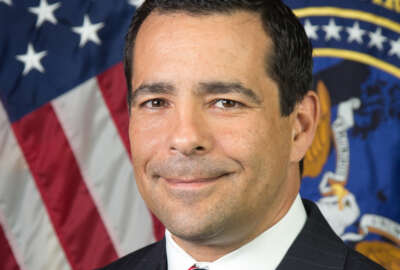

Stakeholders working in the security clearance community say they're seeking clear, consistent leadership to drive major changes to the governmentwide process.
Subscribe to Federal Drive’s daily audio interviews on Apple Podcasts or PodcastOne.
Members of the government security and suitability community are seeking more active leadership from the Trump administration, as officials within the Office of Personnel Management brace for major changes to the security clearance process and slog through a backlog that’s now reached more than 700,000.
Having top leadership involvement is more important now than ever before, industry says, because the security clearance process is back on the Government Accountability Office’s High-Risk List. And the Pentagon, frustrated by OPM’s seemingly insurmountable backlog, is preparing to take back much of the clearance process on its own.
Top leaders at OPM’s National Background Investigation Bureau (NBIB), the Defense Department and the Office of the Director of National Intelligence’s National Counterintelligence and Security Center, along with industry experts, discussed their concerns and ideas to change the security clearance process before the Senate Intelligence Committee.
One key voice, however, was missing.
The Office of Management and Budget declined to appear at Wednesday’s hearing, said Senate Intelligence Committee Vice Chairman Mark Warner (D-Va.).
Warner said he was disappointed by OMB’s absence and hoped the agency would participate in the next committee hearing on the topic.
“This is a pure management problem, it seems to me,” Sen. Angus King (I-Maine) said to a panel of industry and oversight executives at Wednesday’s hearing.
“This is a management problem, and I’ve referred to the Performance Accountability Council, because those are the principles of implementing the reform efforts,” said Brenda Farrell, director of strategic human capital management for the Government Accountability Office.
The Office of Management and Budget’s Deputy Director for Management chairs the Performance Accountability Council. The OPM director, who serves as the suitability executive agent, and the Director of National Intelligence, who leads as the suitability executive agent, also sit on the council.
“I would point to the chair of the Performance Accountability Council because that person does have the authority to provide direction regarding the process [to] carry out those functions,” Farrell said.
“Is that person going to be here today?” King said.
“I believe that person declined,” Farrell said.
“Well that’s kind of ridiculous isn’t it?” King replied.
Margaret Weichert is OMB’s newly confirmed deputy director for management. She was sworn into office in recent weeks.
For ODNI, the chance to bring everyone to the table to discuss significant changes to the security clearance process will come soon.
ODNI will launch the “Trusted Workforce 2.0” initiative next week. The goal is to bring together leadership across government to approach “transformative” changes to the security clearance process with a “clean slate,” said Brian Dunbar, assistant director of the special security directorate at ODNI’s National Counterintelligence and Security Center.
“It is an enterprise effort, sponsored by the security executive agent and the suitability executive agent in concert with our partner organizations, which will bring together key senior leadership, change agents, industry experts and innovative thinkers to chart a bold path forward for the security and suitability credentialing enterprise,” Dunbar said.
Bill Evanina, the NCSC director, is leading the “Trusted Workforce 2.0” initiative, Dunbar’s written testimony reads. The Defense Department said it will support the initiative as well.
Members of industry echoed GAO’s call for top leadership involvement. And though the numbers that describe the current challenges with the federal security clearance process have changed slightly in recent months, the problems are clear.
The backlog of pending investigatory matters sits at 710,000, said Charlie Phalen. It’s significantly higher than the backlog of three years ago, when pending investigations sat at 190,000 in August 2014.
Processing times for initial, secret, top-secret and periodic reinvestigations are well beyond congressional standards. The Intelligence Reform and Terrorism Prevention Act of 2004 required agencies to process 80 percent of security clearances within an average of 90 days, and then the next 90 percent of cases within an average of 40 days by 2009.
The fastest 90 percent of top secret investigations took, on average, more than 300 days during the first quarter of 2018, Dunbar said.
The cost of completing a background investigation has increased by more than 40 percent since 2014, he added.
Yet Senate Intelligence Committee Chairman Richard Burr (R-N.C.) said he was confident government and industry together could tackle current challenges.
“I walk away, to some degree, more optimistic than I came, because the biggest issues that you’ve raised can be solved,” he said. “This is a question of can we put the right people in a room that understand … reciprocity.”
DoD, meanwhile, remains confident in its three-year plan to transfer defense-related personnel clearance work from NBIB to the Pentagon. Defense Department employees and contractors make up the majority — about 75 percent — of government’s total investigatory workload.
DoD will begin to implement its three-year transition plan in October, if the Director of National Intelligence approves the Pentagon’s official transition proposal, said Garry Reid, director for defense intelligence for the Office of the Undersecretary of Defense for Intelligence.
“There is full agreement of everyone I’ve briefed that this methodology is viable and sufficient and goes far beyond where we are today in updating our understanding of risk in the workforce,” he said.
Burr said he was excited and praised the Pentagon’s transition plan.
“The reality is that we can do much better,” he said. “The fact is, the timeline is about exactly where you told us where it was going to be. … We can’t go forward unless we do this.”
Few members at Wednesday’s hearing had concerns with DoD’s plan. Warner questioned whether NBIB and DoD would eventually create duplicative and confusing operations and processes.
“I get the frustration on the DoD side to say, ‘We ought to split this up,'” he said. “But if some of the industry’s interests in terms of [having] application, one investigation, one adjudication and one clearance, it seems like we’re going in the opposite direction.”
Sen. James Lankford (R-Okla.) questioned what lessons DoD had learned from its past, when the department previously owned the security clearance process. GAO, similarly, placed personnel security clearances on its High-Risk List when DoD held responsibility.
“Will this drive down costs, and will this speed up the process?” Lankford asked.
“Yes, and yes,” Reid said. “In terms of speeding the process [under] current timelines, we’re experiencing 150 or so days for a secret level investigation. We will eliminate that requirement completely, so there’s a time improvement there.”
DoD’s studies indicate the Pentagon’s own technology and continuous evaluation capabilities will cut out 90 percent of the fieldwork investigators perform under the current system, Reid added.
As DoD continues to transfer defense-related clearance work from NBIB, the Pentagon will need to ramp up its workforce of federal and contractor investigators. OPM and NBIB, meanwhile, will need to ramp its workforce down as it loses DoD business.
As Federal News Radio has previously reported, DoD’s three-year transition plan could leave major implications for OPM and its budget.
“We have to keep our partner agency whole,” Reid said of OPM. “They support a lot of other agencies in the government, and they rely on us to do that.”
But NBIB, at least now, didn’t express much concern that DoD’s plans would cut deeply into OPM operations or its budget.
“NBIB continues to examine our workforce needs, capacity and budget as we work to minimize disruptions to our operations, our contractors and our customers,” Phalen said. “Certainly, challenges will present themselves going forward; however, through an internal working group at NBIB and continued communication with the members of the PAC principals and DoD, we have come together to carry out this transition.”
Copyright © 2025 Federal News Network. All rights reserved. This website is not intended for users located within the European Economic Area.
Nicole Ogrysko is a reporter for Federal News Network focusing on the federal workforce and federal pay and benefits.
Follow @nogryskoWFED


